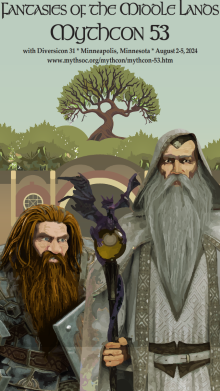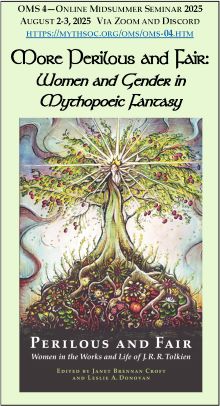Loading...
Location
Minneapolis, Minnesota
Document Type
Presentation
Event Website
https://www.mythsoc.org/mythcon/mythcon-53.htm
Start Date
4-8-2024 10:00 AM
End Date
4-8-2024 10:50 AM
Description
Coming between his tales of the First Age and Lord of the Rings, J.R.R. Tolkien’s The Hobbit occupies a curious middle position in his legendarium. The Hobbit is a children’s text, noteworthy for its lucky main character and its use of an often intrusive narrative voice, but the adventures of Bilbo Baggins and his thirteen companions allowed Tolkien to begin mapping his stories of the First Age onto a new narrative. Elrond, for example, the Master of the Last Homely House, and “one of those people whose fathers came into the strange stories before the beginning of History” (51), is a character from Tolkien’s earlier tales of the First Age. Conversely, The figure of Gollum, as he appears in the revised second edition of The Hobbit, becomes the link between the earlier text and Lord of the Rings; Bilbo’s magic ring lies at the heart of the later book, but the character of Gollum becomes an integral character in the unfolding of events and the destruction of the ring. Finally, The Hobbit functions as a fictional arena in which Tolkien first begins to test his theories of secondary worlds and secondary belief, outlined in his 1939 Andrew Lang lecture, and later essay, “On Fairy-Stories,” where “the story-maker proves a successful sub-creator” (36). I want to argue that the middle position occupied by The Hobbit is central to Tolkien’s creative process, bringing forward elements of The tales of the First Age, laying the groundwork for the events of the Third Age, while providing him a fictional space in which to employ his theories of sub-creation and secondary belief, creating a children’s story with narrative layers and mythological depth and setting a new standard for world building in the fantasy tradition of the twentieth century.
Creative Commons License

This work is licensed under a Creative Commons Attribution-NonCommercial-No Derivative Works 4.0 International License.
Included in
The Sub-Creator and the Secondary World: Positioning The Hobbit in J.R.R. Tolkien’s Legendarium
Minneapolis, Minnesota
Coming between his tales of the First Age and Lord of the Rings, J.R.R. Tolkien’s The Hobbit occupies a curious middle position in his legendarium. The Hobbit is a children’s text, noteworthy for its lucky main character and its use of an often intrusive narrative voice, but the adventures of Bilbo Baggins and his thirteen companions allowed Tolkien to begin mapping his stories of the First Age onto a new narrative. Elrond, for example, the Master of the Last Homely House, and “one of those people whose fathers came into the strange stories before the beginning of History” (51), is a character from Tolkien’s earlier tales of the First Age. Conversely, The figure of Gollum, as he appears in the revised second edition of The Hobbit, becomes the link between the earlier text and Lord of the Rings; Bilbo’s magic ring lies at the heart of the later book, but the character of Gollum becomes an integral character in the unfolding of events and the destruction of the ring. Finally, The Hobbit functions as a fictional arena in which Tolkien first begins to test his theories of secondary worlds and secondary belief, outlined in his 1939 Andrew Lang lecture, and later essay, “On Fairy-Stories,” where “the story-maker proves a successful sub-creator” (36). I want to argue that the middle position occupied by The Hobbit is central to Tolkien’s creative process, bringing forward elements of The tales of the First Age, laying the groundwork for the events of the Third Age, while providing him a fictional space in which to employ his theories of sub-creation and secondary belief, creating a children’s story with narrative layers and mythological depth and setting a new standard for world building in the fantasy tradition of the twentieth century.
https://dc.swosu.edu/mythcon/mc53/schedule/48


